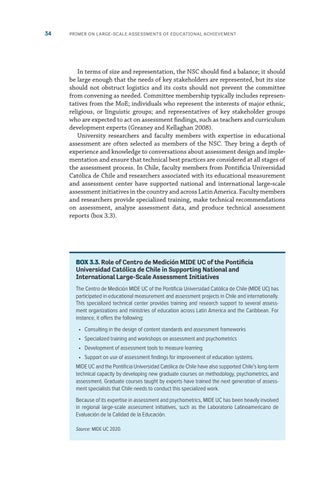34
PRIMER ON LARGE-SCALE ASSESSMENTS OF EDUCATIONAL ACHIEVEMENT
In terms of size and representation, the NSC should find a balance; it should be large enough that the needs of key stakeholders are represented, but its size should not obstruct logistics and its costs should not prevent the committee from convening as needed. Committee membership typically includes representatives from the MoE; individuals who represent the interests of major ethnic, religious, or linguistic groups; and representatives of key stakeholder groups who are expected to act on assessment findings, such as teachers and curriculum development experts (Greaney and Kellaghan 2008). University researchers and faculty members with expertise in educational assessment are often selected as members of the NSC. They bring a depth of experience and knowledge to conversations about assessment design and implementation and ensure that technical best practices are considered at all stages of the assessment process. In Chile, faculty members from Pontificia Universidad Católica de Chile and researchers associated with its educational measurement and assessment center have supported national and international large-scale assessment initiatives in the country and across Latin America. Faculty members and researchers provide specialized training, make technical recommendations on assessment, analyze assessment data, and produce technical assessment reports (box 3.3).
BOX 3.3. Role of Centro de Medición MIDE UC of the Pontificia Universidad Católica de Chile in Supporting National and International Large-Scale Assessment Initiatives The Centro de Medición MIDE UC of the Pontificia Universidad Católica de Chile (MIDE UC) has participated in educational measurement and assessment projects in Chile and internationally. This specialized technical center provides training and research support to several assessment organizations and ministries of education across Latin America and the Caribbean. For instance, it offers the following: • Consulting in the design of content standards and assessment frameworks • Specialized training and workshops on assessment and psychometrics • Development of assessment tools to measure learning • Support on use of assessment findings for improvement of education systems. MIDE UC and the Pontificia Universidad Católica de Chile have also supported Chile’s long-term technical capacity by developing new graduate courses on methodology, psychometrics, and assessment. Graduate courses taught by experts have trained the next generation of assessment specialists that Chile needs to conduct this specialized work. Because of its expertise in assessment and psychometrics, MIDE UC has been heavily involved in regional large-scale assessment initiatives, such as the Laboratorio Latinoamericano de Evaluación de la Calidad de la Educación. Source: MIDE UC 2020.

